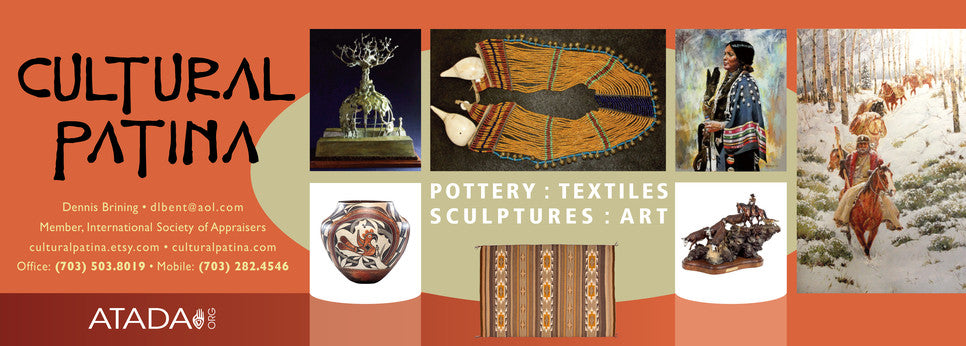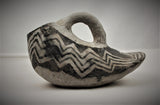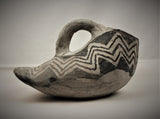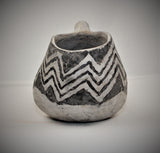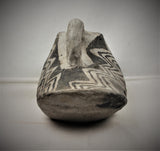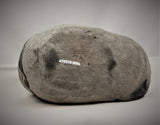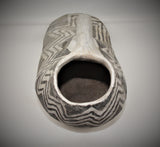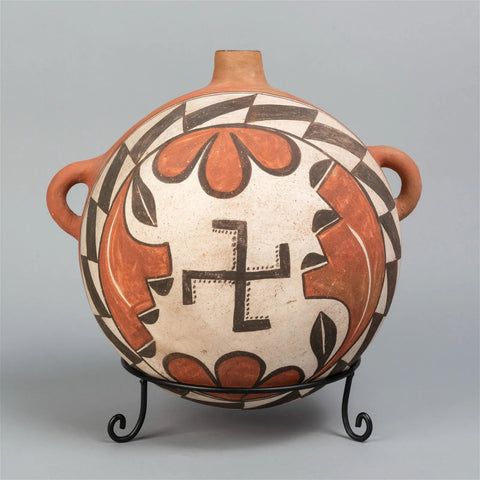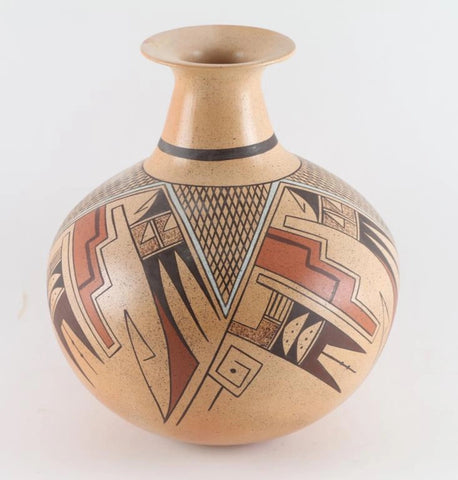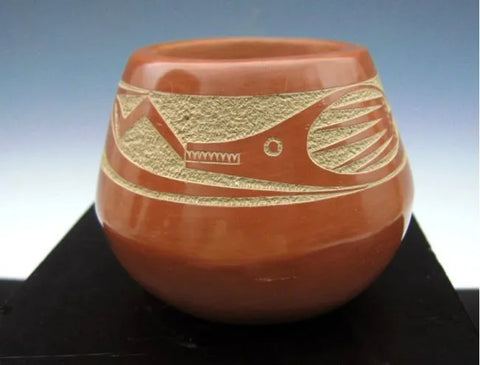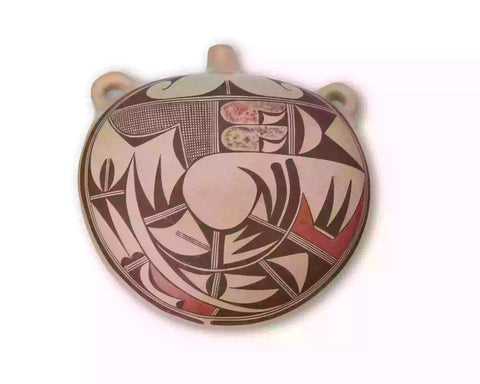
Rare Ancestral Puebloan Mesa Black on White Duck Pitcher, Ca. 900-1000 A.D., #1670
$ 3,150.00
Description: #1670 Rare Ancestral Puebloan Mesa Black on White Duck Pitcher, Ca. 900-1000 A.D., #1670. Black on white decorated avian form pitcher having a loop handle and wide mouth. Black on white lighting bolt design. A scarce type.
Condition: Intact, some very minor imperfections. Overall exc. cond.
Dimensions: 4-1/4”H. x 7”L.
Provenance: Florida collection, purchased from Andrews Pueblo Pottery, NM., 7/1/1993
Ancient Pueblo peoples, Ancestral Pueblo peoples , or Ancestral Puebloans were an ancient Native American culture centered on the present-day Four Corners area of the United States, comprising southern Utah, northeastern Arizona, northern New Mexico, and southwestern Colorado.[1] They lived in a range of structures, including pit houses, pueblos, and cliff dwellings designed so that they could lift entry ladders during enemy attacks, which provided security. Archaeologists referred to one of these cultural groups as the Anasazi, although the term is not preferred by contemporary Pueblo peoples.[2]
The word Anaasází is Navajo for "Ancient Ones" or "Ancient Enemy".[3] Archaeologists still debate when this distinct culture emerged. The current consensus, based on terminology defined by the Pecos Classification, suggests their emergence around the 12th century BCE, during the archaeologically designated Early Basketmaker II Era. Beginning with the earliest explorations and excavations, researchers wrote that the Ancient Puebloans are ancestors of contemporary Pueblo peoples.[1][3] (Source Wikipedia)
“Pueblo pottery is made using a coiled technique that came into northern Arizona and New Mexico from the south, some 1500 years ago. In the four-corners region of the US, nineteen pueblos and villages have historically produced pottery. Although each of these pueblos use similar traditional methods of coiling, shaping, finishing and firing, the pottery from each is distinctive. Various clays gathered from each pueblo’s local sources produce pottery colors that range from buff to earthy yellows, oranges, and reds, as well as black. Fired pots are sometimes left plain and other times decorated—most frequently with paint and occasionally with appliqué. Painted designs vary from pueblo to pueblo, yet share an ancient iconography based on abstract representations of clouds, rain, feathers, birds, plants, animals and other natural world features.
Tempering materials and paints, also from natural sources, contribute further to the distinctiveness of each pueblo’s pottery. Some paints are derived from plants, others from minerals. Before firing, potters in some pueblos apply a light colored slip to their pottery, which creates a bright background for painted designs or simply a lighter color plain ware vessel. Designs are painted on before firing, traditionally with a brush fashioned from yucca fiber.
Different combinations of paint color, clay color, and slips are characteristic of different pueblos. Among them are black on cream, black on buff, black on red, dark brown and dark red on white (as found in Zuni pottery), matte red on red, and polychrome—a number of natural colors on one vessel (most typically associated with Hopi). Pueblo potters also produce undecorated polished black ware, black on black ware, and carved red and carved black wares.
Making pueblo pottery is a time-consuming effort that includes gathering and preparing the clay, building and shaping the coiled pot, gathering plants to make the colored dyes, constructing yucca brushes, and, often, making a clay slip. While some Pueblo artists fire in kilns, most still fire in the traditional way in an outside fire pit, covering their vessels with large potsherds and dried sheep dung. Pottery is left to bake for many hours, producing a high-fired result.
Today, Pueblo potters continue to honor this centuries-old tradition of hand-coiled pottery production, yet value the need for contemporary artistic expression as well. They continue to improve their style, methods and designs, often combining traditional and contemporary techniques to create striking new works of art.” (Source: Museum of Northern Arizona)
Condition: Intact, some very minor imperfections. Overall exc. cond.
Dimensions: 4-1/4”H. x 7”L.
Provenance: Florida collection, purchased from Andrews Pueblo Pottery, NM., 7/1/1993
Ancient Pueblo peoples, Ancestral Pueblo peoples , or Ancestral Puebloans were an ancient Native American culture centered on the present-day Four Corners area of the United States, comprising southern Utah, northeastern Arizona, northern New Mexico, and southwestern Colorado.[1] They lived in a range of structures, including pit houses, pueblos, and cliff dwellings designed so that they could lift entry ladders during enemy attacks, which provided security. Archaeologists referred to one of these cultural groups as the Anasazi, although the term is not preferred by contemporary Pueblo peoples.[2]
The word Anaasází is Navajo for "Ancient Ones" or "Ancient Enemy".[3] Archaeologists still debate when this distinct culture emerged. The current consensus, based on terminology defined by the Pecos Classification, suggests their emergence around the 12th century BCE, during the archaeologically designated Early Basketmaker II Era. Beginning with the earliest explorations and excavations, researchers wrote that the Ancient Puebloans are ancestors of contemporary Pueblo peoples.[1][3] (Source Wikipedia)
“Pueblo pottery is made using a coiled technique that came into northern Arizona and New Mexico from the south, some 1500 years ago. In the four-corners region of the US, nineteen pueblos and villages have historically produced pottery. Although each of these pueblos use similar traditional methods of coiling, shaping, finishing and firing, the pottery from each is distinctive. Various clays gathered from each pueblo’s local sources produce pottery colors that range from buff to earthy yellows, oranges, and reds, as well as black. Fired pots are sometimes left plain and other times decorated—most frequently with paint and occasionally with appliqué. Painted designs vary from pueblo to pueblo, yet share an ancient iconography based on abstract representations of clouds, rain, feathers, birds, plants, animals and other natural world features.
Tempering materials and paints, also from natural sources, contribute further to the distinctiveness of each pueblo’s pottery. Some paints are derived from plants, others from minerals. Before firing, potters in some pueblos apply a light colored slip to their pottery, which creates a bright background for painted designs or simply a lighter color plain ware vessel. Designs are painted on before firing, traditionally with a brush fashioned from yucca fiber.
Different combinations of paint color, clay color, and slips are characteristic of different pueblos. Among them are black on cream, black on buff, black on red, dark brown and dark red on white (as found in Zuni pottery), matte red on red, and polychrome—a number of natural colors on one vessel (most typically associated with Hopi). Pueblo potters also produce undecorated polished black ware, black on black ware, and carved red and carved black wares.
Making pueblo pottery is a time-consuming effort that includes gathering and preparing the clay, building and shaping the coiled pot, gathering plants to make the colored dyes, constructing yucca brushes, and, often, making a clay slip. While some Pueblo artists fire in kilns, most still fire in the traditional way in an outside fire pit, covering their vessels with large potsherds and dried sheep dung. Pottery is left to bake for many hours, producing a high-fired result.
Today, Pueblo potters continue to honor this centuries-old tradition of hand-coiled pottery production, yet value the need for contemporary artistic expression as well. They continue to improve their style, methods and designs, often combining traditional and contemporary techniques to create striking new works of art.” (Source: Museum of Northern Arizona)
Related Products
Sold out
